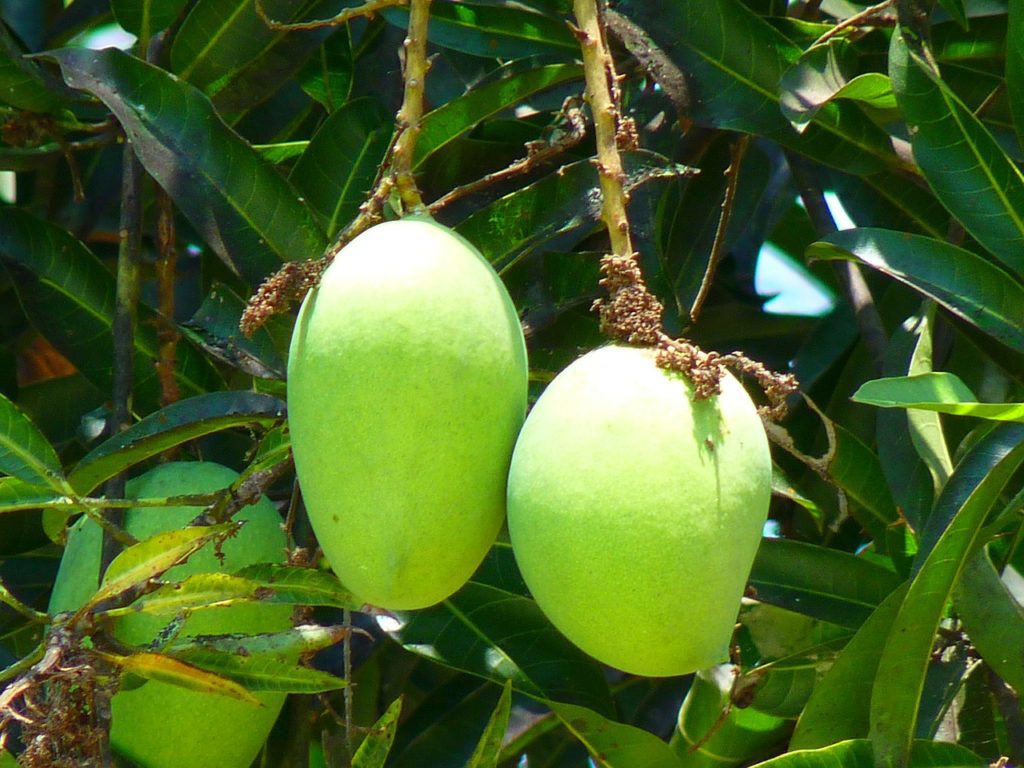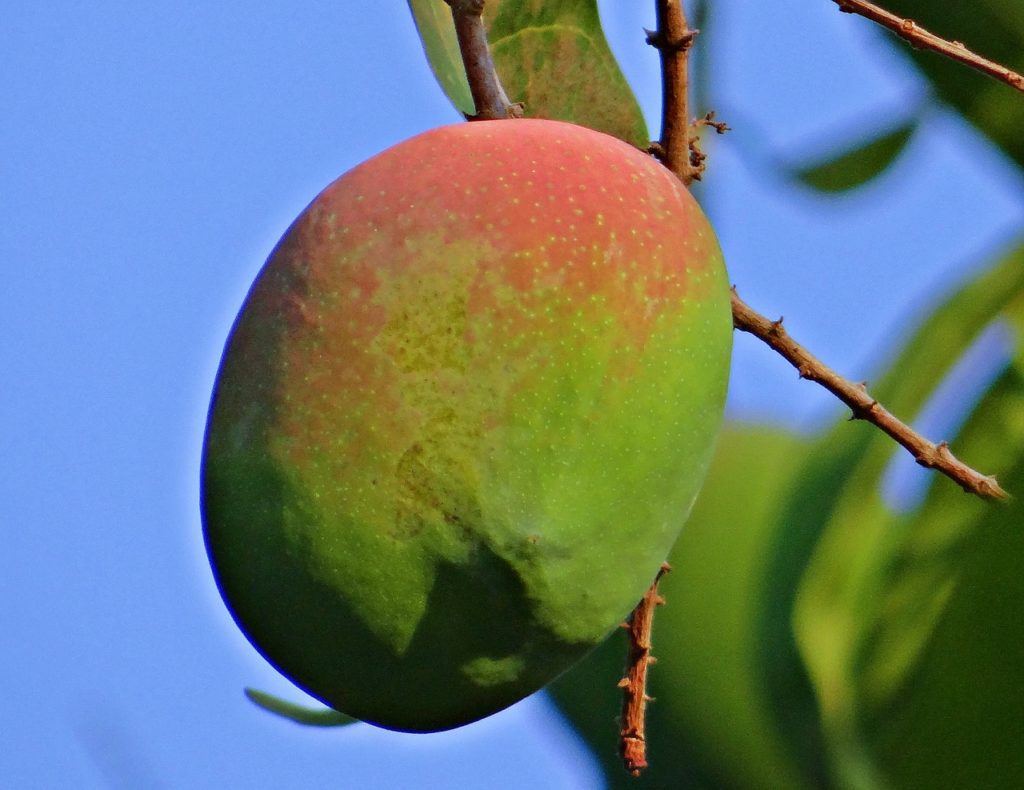Mango tree are self-pollinating so you will only need 1 tree to grow fruit. Many mango tree species grow flowers contain both male and female parts and can be pollinated by the wind, bees and other pollinating insects. Other mango species grow male and female flowers on the same tree that self pollinate.
Mangoes will grow multiple fruit from the same stem once pollinated. The flowers are large and can carry heavy fruit until they are ripe. Overripe fruit will drop off the tree so make sure you pick them off before they become too orange. Mangoes love full sun and will grow more fruit the more sun they get.

How mango trees are pollinated
Mango trees grow large yellow flower stems that appear in Spring and Summer and open up to have multiple flower buds. The flower contains the female stigma and male anthers which contain the pollen. When the pollen is transferred to the female stigma the flower is fertilized and the fruit will grow.
The pollen can move to the stigma when insects come to collect nectar, when the wind blows wind or by hand pollination. Mango trees that are planted out in yards will usually be pollinated by insects.
The more flowers you have planted in your yard, the more insects that will be attracted. This means there will be a greater chance of self-pollination.

How a mango tree is pollinated
The top 3 ways that mango trees get pollinated include insects, the wind and hand pollination.
1. Wind
Outdoor mango trees can be pollinated when the wind blows the pollen into the center of the flower. The pollen will be lightly attached to male anthers so wind can move it onto the sticky stigma in the middle of the flower.
For trees in sheltered areas or for trees with a dense leaf canopy it can be harder for the pollen to move into the flower. Keeping the tree trimmed so that there is space for the wind to move the flowers around can help the pollen to move into the flower.

2. Insect pollinators
Insects will come from far and wide to visit a mango tree flower to pollinate it. Bees, wasps and flies can find their way to the flowers, quickly moving from flower to flower and taking pollen with them. Bees with their furry bodies will be covered with pollen after vising the flowers.
In Australia research has shown that common pollinators for mango trees are native flies1. Research conducted in Queensland showed that there were over 50 different types of insects that visited Mango flowers ranging from flies, bees and even beetles1.
There were more flies visiting mango flowers than bees and they moved pollen very effectively. This means that you should let the natural insect balance find its way and let flies come to visit your mango flowers to help to move pollen.

3. Hand pollination
Hand pollination can be done to deliberately mix two mango species together. You can create your own hybrid fruit by mixing the pollen between two different trees. The seed created will have the genetic mix of both plants and a new individual plant can be grown by seed.
The flowers can be rubbed together by hand to move the pollen from one to another. This will create a new variety that you can grow at home.
This is a long process and farmers will work for many years to create a new mango tree that has the characteristics they want. Bigger, sweeter fruit or a hardy plant can come from mixing two mango trees together.
How to increase successful pollination in mango trees
To increase the chance of successful pollination for your mango trees there are a few steps you can take at home.
Plant mango trees in full sun
Sun is important to increase pollination and produce more fruit from your mango tree. It will grow more flowers and therefore attract more pollinating insects. Mango trees grown in tropical climates will thrive in a full sun position as they will have milder winters and humid summers.
Plant flowering plants nearby
To increase the pollination rates of mango tree flowers attract more insects to your garden by planting more annual and perennial flowers. Surround your mango tree with flowering plants like violas, daisies and Gaura to bring more bees to your garden.
Avoid planting them too close to the mango tree’s roots because they need plenty of space. Having flowering plants in your yard will be close enough to attract the bees.
Are mango trees self-pollinating? | Summary
Mango trees are self-pollinating so you will only need one plant to grow fruit. The flowers can be both male and female or the tree can grow individual male and female flower depending on the species. Outdoor mango trees will be pollinated by insects or the wind but those grown in greenhouses will need to be hand pollinated.
My new mango was planted in Fall and this will be its first Spring in the ground. This tree won’t have flowers this year but when it does in the next year we are hopeful for some fruit. New mango trees seem like they are doing nothing over winter but when Spring arrives it will grow new leaves and stems.
Mango trees are worth the wait and for a quick growing tree a seedling mango is a great choice. If you want fruit sooner, choose a grafted mango tree and you may have fruit in the next year.
For more on this check out my previous article here: Grafted mango tree vs seedling mango tree | Which is better?
Happy growing.
Mango Tree Articles
- Mango trees growing slow | How to help them grow 2X faster
- How to stake a mango tree | Step-By-Step Guide
- Grafted mango tree vs seedling mango tree | Which is better?
- Are mango trees evergreen? | Do they lose their leaves in Winter?
- Are mango trees self pollinating? | Do I need more than 1 mango tree?
- Growing mango trees in containers | Simple steps to success
- Where to plant a mango tree | Easy guide for your yard
- How often to water a mango tree | Spring, summer + winter guide
References
ABC, 2015, Native flies, not bees, are a mango farmer’s best friend, Accessed 18th September, 2021, https://www.abc.net.au/news/rural/2015-06-12/new-study-shows-flies-not-bees-are-mango-farmers-best-friend/6540674
I am an accredited practicing dietitian, experienced gardener and a dedicated cook. I love writing and sharing my experience so you can learn from my successes and mistakes.
